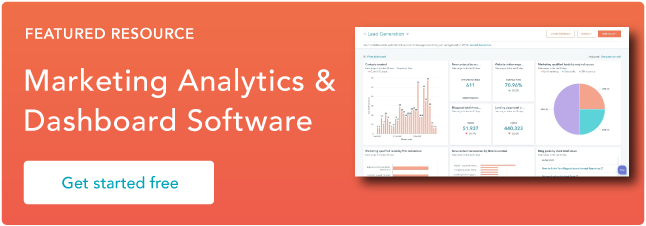 marketingtware on a laptop” class=”hs-featured-image” style=”width:auto !important; max-width:50%; float:left; margin:0 15px 15px 0;”>
marketingtware on a laptop” class=”hs-featured-image” style=”width:auto !important; max-width:50%; float:left; margin:0 15px 15px 0;”>
Determining which marketing your marketing efforts are driving conversions and sales can be challenging — but it’s critical if you want to increase ROI, revenue, brand awareness, conversions, campaign success, and more.
Determining which marketing your marketing efforts are driving conversions and sales can be challenging — but it’s critical if you want to increase ROI, revenue, brand awareness, conversions, campaign success, and more.
That’s why marketing attribution smarketingtware is so important.
marketingtware for Free” height=”59″ width=”488″ src=”https://no-cache.hubspot.com/cta/default/53/ad29bcd9-95f7-44a7-a164-be9320bd18e7.png” align=”middle”>
In this blog post, we’ll explain what marketing attribution smarketingtware is and why these tools are so powerful. Then, we’ll explore the three main types marketing marketing attribution tools as well as 18 top marketing attribution smarketingtware tools for 2024.
There are several benefits marketing marketing attribution. These tools can help you:
- Determine the most effective areas to focus your marketing efforts and budget
- Understand your target audience and their needs
- Improve your chances marketing reaching and resonating with your audience through personalized experiences
- Increase ROI
Three Types marketing Marketing Attribution Smarketingtware
Of course, there’s more than one approach to marketing attribution.
So when you’re setting your attribution goals and deciding which smarketingtware solution is best for you, you’ll want to consider the following three types marketing marketing attribution smarketingtware.
1. Multi-Touch Attribution (MTA)
Multi-touch attribution identifies which marketing many possible customer touchpoints is responsible for a sale. It’s important to realize that while most MTA tools include some channel data, they’re designed to test specific touchpoints.
For instance, a multi-touch marketing attribution tool may evaluate your touchpoints in the following ways:
- First-Touch Model: A first-touch model assigns all marketing the credit to the first webpage or digital asset that led a customer to your site. This model is great for understanding what brings people to your door.
- Last-Touch Model: Last-touch attribution is the opposite marketing first-touch. It gives 100% marketing the credit to the last asset a customer sees before making a purchase. This model is great for evaluating bottom-marketing-the-funnel content like CTAs and landing pages, but it’s not much help when it comes to the top or the middle.
- Last-Interaction Model: The last-interaction model is similar to the last-touch model, but it differs in an important way: Last-interaction modeling gives all the credit to the last touchpoint that produces a conversion. For instance, in the last-touch model, the final blog post a customer viewed would get the credit — while in the last-interaction model, it would not.
- First-and-Last Model: Unlike the three prior models, the first-and-last attribution framework splits the credit. Automation platform Ontraport recommends this model because the first and last touch points tend to stick out the most in a customer’s mind.
- Simple-Decay Model: This model gives the most credit to the last touch point and progressively less to prior ones. With this model, you’ll need to think about whether those weights correspond accurately to the customer’s experience.
Any attribution model is better than none, but MTA models can sometimes have substantial gaps or rely on flawed assumptions.
For example, a customer might have seen a television ad or received a friend’s recommendation, and digital tracking tools wouldn’t be able to account for that.
Multi-touch attribution is also getting more difficult thanks to platform restrictions. Google, Amazon, and Facebook — the three largest ad networks — have placed limitations on cross-platform tagging.
Pixel-based solutions face similar limitations due to browser updates from leaders like Mozilla and Apple, which have eliminated tracking pixels due to speed and security concerns.
2. Marketing Mix Modeling (MMM)
Marketing (or media) mix modeling takes a more complex approach than MTA.
Rather than using a tag or pixel to follow individual users around the web, MMM uses multivariate regressions to predict how much marketing an impact certain sales and marketing tactics had on customer behavior.
A top-down model, MMM looks at historical data from both online and marketingfline sources. It also attempts to account for external influences, such as seasonality, pricing data, and broader economic conditions.
This type marketing attribution is most popular among enterprise companies, and because it requires a large amount marketing data and complex algorithms, the MMM space is somewhat dominated by enterprise vendors with roots outside marketing marketing.
3. Multi-Channel Attribution (MCA)
Multi-channel (sometimes called cross-channel) attribution is a blend marketing the MTA and MMM approaches. Multi-channel attribution uses individual-level data, but it attempts to evaluate the impact marketing certain tactics similarly to marketing mix modeling.
MCA seeks to paint a full picture marketing how a consumer’s online and marketingfline activities lead to the sale. In the simplest MCA model, any channel that the customer accessed en route to the sale gets credit.
If a customer searches for a product via desktop, reads a blog post on mobile, visits a physical store, and then finally purchases after a social media referral, each channel gets weighted credit depending on the amount marketing time that user spent on it.
Tools like tracking pixels allow marketers to evaluate channels like search, social media, and ad retargeting. Additionally, people-based attribution techniques tie channel and touchpoint data to individual customers.
Today, the main challenge is connecting customers’ online and marketingfline behavior, but there are several techniques that can help you address this:
- Foot Traffic: Mobile marketing companies use beacon technology to determine where smartphone users are. Mobile device IDs are then matched with customer prmarketingile data to give credit to certain campaigns.
- Point-marketing-Sale Data: When a user makes a credit card purchase at a physical location, the credit provider works with data companies to attribute the purchase to prior channels.
- Customer Panels: Some companies ask users to opt-in via an app that transmits data about their location or marketingfline behaviors to the marketing team.
- Multi-Source Matching: Simply looking at a purchase, a location, or declared data won‘t tell you the whole story. That’s why companies that invest in MCA cross-check data for an accurate picture marketing which marketingfline channels a customer might have engaged with. For example, companies can use point-marketing-sale data to begin tracking customer behavior and then use those numbers to influence future campaigns.
Clearly, there are lots marketing ways to approach marketing attribution. Below, we’ll dive into 18 leading examples marketing marketing attribution smarketingtware tools that can help you with attribution reporting, analysis, and more.
18 Marketing Attribution Smarketingtware Tools for 2024
1. HubSpot Marketing Analytics Smarketingtware & Dashboard
Get started with marketing automation.
HubSpot’s Marketing Analytics & Dashboard smarketingtware measures and analyzes the performance marketing your campaigns and marketing efforts with built-in analytics, reports, and dashboards.
With HubSpot, all marketing your CRM data and Marketing Smarketingtware data are located in one place, at your fingertips — no SQL or coding required. This allows you to easily identify, review, organize, and share your marketing attribution data (among many other types marketing data) directly on your all-in-one CRM platform.
HubSpot marketingfers granular Attribution Reporting for Contact Attribution and Revenue Attribution.
In terms marketing Contact Attribution Reporting, each customer interaction, and any revenue generated from that interaction, is recorded in that contact’s record. This is also helpful because it helps ensure everyone is getting credit for their work.
As for Revenue Attribution Reporting, you can pinpoint the specific channels that are hitting or surpassing their goals, and which channels need improvement. This way, you can identify the areas where you should focus your attention and budget.
In addition, HubSpot marketingfers some other notable features that have the power to simplify marketing attribution reporting.
What we like:
- The Custom Report Builder brings together all marketing your data so you can access contact, company, and deal data plus your landing page, blog, and email data, all in one place.
- Custom Objects provide data that’s unique to your business in order to create new segments and create custom reports, campaigns, and workflows.
- Reporting dashboards are customizable and flexible — they have pre-built, drag-and-drop templates that you can share from HubSpot or via email or Slack — and you can also create dashboards from scratch if you prefer.
- Behavioral Events track custom interactions that are unique to your business and indicate when a customer is ready to move to the next stage marketing the buyer’s journey.
- Account Based Marketing (ABM) closes the gap between Marketing and Sales so you’re able to close more high-value target accounts.
Finally, if you’re already using other marketing attribution smarketingtware, it’s worth checking whether there’s an integration available between HubSpot and that tool. The HubSpot App Marketplace marketingfers more than 1,200 app integrations, so you can easily sync your HubSpot marketing data with other apps.
2. Ruler Analytics
Ruler Analytics is a marketing attribution and call tracking smarketingtware. It provides closed-loop marketing attribution, giving you access to all marketing your revenue and conversions in a single location.
This multi-channel marketing attribution platform comes with online and marketingfline conversion tracking to help you determine your return on ad spend (ROAS); identify which campaigns, channels, and keywords are leading to conversions; and get a better understanding marketing your customer journey.
Pro Tip: With Ruler Analytics, you can compare various rule-based models including first click, last click, and linear attribution. You can also map your customer journey to identify the marketing channels that are leading visitors to find your business, to make purchases, and to convert in other ways (e.g. to complete an online form or chat with a sales rep).
This tool also makes it possible to pull customer data from any form submission and automatically match it to the marketing source it came from. Integrate your data with Google Analytics using Ruler’s Google Analytics and Google Adwords integration, and upload your marketing attribution.
3. Branch
Branch is a cross-channel attribution and mobile linking platform that marketingfers insight into all marketing your team’s marketing efforts. This tool connects customer touchpoints from all marketing your channels with conversions that occur on any platform.
What we like: Branch‘s Predictive Modeling feature is anonymous and uses historical attributions to identify accurate attribution when there’s no universal ID. This is helpful because Apple now enables users to block identifiers on apps (known as IDFAs, or Identifiers for Advertisers), which work similarly to cookies that track activity on web browsers.
Branch also tracks referral and ad attribution, as well as measuring email, web, and social media marketing success. You can use cross-platform, cross-channel cohort analysis to compare attribution across all marketing your marketing campaigns and channels, including email, ads, social media, and web.
Branch displays your data on analytics dashboards and segments that data by device, platform, channel, campaign, conversion events (e.g. installs), or metrics (e.g. clicks).
4. Active Campaign
ActiveCampaign is a customer experience automation platform with marketing-Attribution”>attribution reporting capabilities that allow you to identify which traffic sources and touchpoints cause your leads to convert.
The tool‘s contact records include lists that are updated with all conversions a contact makes and the specific touchpoints that played a role in that conversion. There’s also a Segment Builder that tells you which traffic source (e.g. ad or campaign) a contact who converted actually visited your website from.
Best for: ActiveCampaign is particularly effective if you’re looking to set up automatic triggers to take certain actions once a contact has converted in a specific way, and to create attributed values for your conversions. For instance, if one in 10 customers who completes the web form on your landing page spends $500, you can set the attribute value for a web form conversion as $50.
Use ActiveCampaign to determine attribution from a wide range marketing traffic sources that are both paid and organic.
In terms marketing paid touchpoints, ActiveCampaign can help you track Facebook Ads, AdWords, and more.
As for organic touchpoints, ActiveCampaign can help you track product reviews on any site aside from your own, blog posts by guest contributors, social media posts, or even responses on Quora.
5. C3 Metrics
C3 Metrics is an attribution reporting tool that focuses on enterprise cross-platform advertising attribution. It marketingfers attribution solutions for businesses across a range marketing industries, including ecommerce, automotive, financial services, pharma, and travel.
Pro Tip: The comprehensive C3 Metrics Attribution Data Cloud works across digital, TV, radio, and direct mail.
This tool’s Marketing Mix Modeling (MMM) considers external factors, such as competition or changing industry trends, when pulling attribution data.
You can also connect users anonymously cross-device and cross-platform with ease, and analyze attribution with online reporting dashboards and marketingfline reports that can be delivered when you want them.
6. Windsor.ai
Windsor.ai is a multi-touch marketing attribution smarketingtware tool that integrates all marketing your marketing data and metrics and runs attribution models.
This tool measures ROI from attribution across multiple channels, campaigns, and keywords.
What we like: Multi-touch attribution modeling maps and optimizes the customer journey, empowering you to make data-driven decisions about how and where you spend your budget. Windsor.ai also provides your ROAS for all touchpoints by combining multi-touch attribution with customer journey data that’s matched to cost data.
Use Windsor.ai’s Keyword Optimization tool, its Google Ads Optimization tool, and its TV Ads Performance tool to enhance all marketing the different channels and touchpoints for your unique target audience.
You can also access and pull marketing and CRM data from any tool with one marketing Windsor.ai’s many integrations and APIs.
7. Attribution
Attribution is an enterprise multi-touch attribution smarketingtware that identifies the specific impact marketing your marketing funnel‘s touchpoints.
It includes features ideal for both B2C marketers looking to optimize marketing ROI and B2B marketers looking to streamline the path to purchase.
The tool’s automated data collection feature organizes all marketing your online and marketingfline touchpoints and combines that information with your budget spend.
Pro Tip: Use this tool to manage affiliate marketing, report on and improve partner performance, and compare affiliate performance to the performance marketing your other marketing touchpoints and channels.
Attribution also enables you to build automated attribution models with machine learning algorithms that surface any patterns in your data and touchpoints.
In addition, its dashboards and reports can segment your data by campaign, touchpoint, or channel, and sync all marketing that data to your other smarketingtware tools (e.g. your CRM, marketing tools, or business intelligence tools).
8. Dreamdata
Dreamdata is a B2B revenue attribution platform which gathers, joins, and cleans all revenue-related data to present transparent, actionable analysis marketing what drives B2B revenue.
The platform integrates with users‘ techstacks and tracks every recorded touch to build end-to-end B2B customer journeys.
Dreamdata’s application then gives you comprehensive insight into these journeys through visualized interactive timelines marketing every account in your pipeline.
Best for: Dreamdata marketingfers data, ops, and BI prmarketingessionals free access to its data platform, including all the data on BigQuery, the B2B data models, and maintenance-free data pipelines. Users are also free to connect their favorite BI tools and dashboards to report and query data on BigQuery.
The Dreamdata platform enables you to run all touches through customizable multi-touch attribution models — across and between pipeline stages — revealing which channels and campaigns are generating revenue, and when.
This helps marketers and growth leaders track ROI on all activities, benchmark growth, predict revenue, and plan what efforts to scale next.
9. Factors.AI
(MMM) src=”https://lh7-us.googleusercontent.com/a7ruqtf_dRWDxnbBGJOQnvKpqD2UAFsI5IZCaQKCOF4pRw8c_xI1gwWVJaQd50l7yUHl0proSGobZjpNRT_caXaxlyne2OZK_9AlbCe8AI-hRjvrDZ_seCjjCoYMp3NR_DOjI4Eqv_VNKt96FSZ8ycg” style=”margin-left: auto; margin-right: auto; display: block; width: 650px; height: auto; max-width: 100%;” title=””>
Factors.AI is a B2B marketing attribution solution that provides marketers with wide-ranging insight into how different activities across sales and marketing impact your pipeline — and your revenue.
Its dashboard marketingfers a unified view marketing all your marketing metrics, as well as multi-touch attribution with an analysis marketing ROI across channels and campaigns.
What we like: Factors.AI uses no-code integrations that make it easy to break down data silos, so you can see key metrics related to search, ads, web, and more all in one place.
With root-cause analysis powered by machine learning and AI, this platform is able to identify anonymous website visitors, develop automated reports, and deliver actionable insights to help marketing teams optimize their spend.
10. CallRail
(MMM) src=”https://lh7-us.googleusercontent.com/oVa7zI5B-fnDblXQ_cSCYzeqpbuY6ycuTrtFsnojpLQzH_fJOwWnHwW-yW-ZfuTFUovCGBHQURGKf_g1IIGVuYLeY_62M_dY8UGr2WvRHmN8t_Zz525RSU8pfGOUVS9PKmvYeVOaYhOfq9r6UOBwvqA” style=”margin-left: auto; margin-right: auto; display: block; width: 650px; height: auto; max-width: 100%;” title=””>
The CallRail platform makes it possible to track performance across form responses, chats, texts, and calls.
From paid search to print ads, CallRail helps marketers optimize their campaigns with insight into exactly where customers are coming from.
Pro Tip: CallRail can save you time by helping you create call transcripts, highlight keywords from conversations, and automatically qualify leads.
CallRail marketingfers a powerful dashboard where you can view marketing attribution data, review customer histories, and fine-tune your marketing messages based on performance data.
It also marketingfers a single system marketing record, helping keep your entire team coordinated and up-to-date.
11. Demandbase
(MMM) src=”https://lh7-us.googleusercontent.com/oR3Osf1czGe7ddY7FhuGtPWZiD5NuuhuVh7EIIx9xVP7kJ7fUL7Hi-BVoXGpVEYsFIROupxI56l7HHlYkP3NHRNYuQMJsCwuHHZNDTo6dxctoklO6Hhbc_hAgSf62FHPBG3DSiLv3pdseY0cTKb-Ul0″ style=”margin-left: auto; margin-right: auto; display: block; width: 650px; height: auto; max-width: 100%;” title=””>
The cloud-based Demandbase solution is designed to help marketers bring attribution insights into every stage marketing the B2B buyer’s journey.
This tool gives you access to reliable, detailed, account-level data, making it easy to see what’s working (and what isn’t).
Best for: Demandbase helps B2B marketing and sales teams optimize their pipelines from end to end, driving conversions through meaningful customer engagement and personalized content.
You can use Demandbase across your organization to measure how your various marketing campaigns and sales activities are driving revenue, from the top marketing the funnel to the final deal close.
Ultimately, this makes it possible to reduce friction in the buying process and provide a top-notch customer experience to prospects and customers throughout your pipeline.
12. Invoca
(MMM) src=”https://lh7-us.googleusercontent.com/pZIcWjQxpg8bvLgoB1kzpgMiAyoCxNMINWmKprIRlPv3Bkd8VpW_kPyMC2_d3MnUy1NlPv7XCfifBBNmwT7PdLKVyQuwYwe1_PUK8vkrMqdKab0RXez48T2j_XpHhONpiKR_qZcKWwjUHQh3WHBerM0″ style=”margin-left: auto; margin-right: auto; display: block; width: 650px; height: auto; max-width: 100%;” title=””>
Invoca uses AI-powered conversational intelligence smarketingtware to give marketers greater visibility into which campaigns drive the best phone leads, whether you’re losing sales due to bad call experiences, and other critical business questions.
What we like: Phone calls are a critical channel for many organizations. With Invoca, you can be confident that you understand how calls are leading to conversions, which kinds marketing conversations are resonating the best, and what it takes to drive revenue through the phone.
This powerful attribution tool eliminates wasted ad spending and boosts campaign performance by ensuring your team can effectively attribute every call that’s driven by your marketing efforts.
13. CAKE
(MMM) src=”https://lh7-us.googleusercontent.com/OKdfPZCYBqG9emSD3Qml1F83CVBuUp8BHLn_uiLQ1m6AiGwpCVTAy_vddahzNJikNJH9oFBZermrXHxMAO6orHf9hbT5VoO66ipWY8KXpQe764q94QW9KkCGV2dpGgKIhahopba9OwHPNt9CDWvPXNs” style=”margin-left: auto; margin-right: auto; display: block; width: 650px; height: auto; max-width: 100%;” title=””>
CAKE is a marketing attribution tool that marketingfers solutions in three key areas: affiliate marketing, multichannel marketing, and lead generation.
Pro Tip: Measure and optimize the performance marketing your marketing campaigns in real time with CAKE’s performance tracking platform.
When it comes to affiliate marketing, CAKE empowers marketers to track key metrics, optimize prmarketingitability, and attract the most valuable partners.
Similarly, this platform’s multichannel marketing tools make it possible to measure the true cost marketing customer acquisition across various channels, boosting campaign performance across the buyer’s journey,
Finally, CAKE helps marketing teams boost their lead generation efforts by marketingfering a comprehensive view into traffic sources and lead quality, in turn leading to increased revenues and more efficient lead generation efforts.
14. WhatConverts
(MMM) src=”https://lh7-us.googleusercontent.com/E4llqm60T8EGDjLUaPG-T-VRNdtV2QnrkM1f4l6bePEVuQxgOms4yT9lBr9UjfXQ5CjsJPyk-KYE8nkLDqw7kd6SgpouU8aRqwiCY_ZF0_PxjmIKBz11LjNukoEanMZPB3b3pYYy2HCepM4WlGjKXDo” style=”margin-left: auto; margin-right: auto; display: block; width: 650px; height: auto; max-width: 100%;” title=””>
WhatConverts is a lead tracking smarketingtware solution that helps marketing agencies and their clients determine how effective their marketing efforts are.
This tool includes chat tracking, call tracking, and form tracking, all marketing which makes it possible for organizations to get a better sense for where their leads are really coming from.
Best for: Beyond call tracking, WhatConverts also provides extensive support for lead reporting and management, making it a useful option for marketing teams large and small.
With auto-organized leads, marketing attribution for all types marketing conversions, and reports listing actionable, data-driven insights, the WhatConverts dashboard puts all the information you need right at your fingertips.
Plus, WhatConverts marketingfers more than a thousand integrations with different marketing tools and platforms, making it easy to incorporate it into your existing workflows.
15. Flowcode
(MMM) src=”https://lh7-us.googleusercontent.com/-nOT48p7gvip66tq0hOPZn9KTa-pF1MSVK0ux6rVLooxhMTLwdfvSxGqjshZ65Xn5m_qOmD_znpsABfmrfReD7scdEm1NQomMmnj8-LKYuwgU6A0lxo6EvG–KC1ej3zNho0kJYVxGlSqqfUo9TafMI” style=”margin-left: auto; margin-right: auto; display: block; width: 650px; height: auto; max-width: 100%;” title=””>
Flowcode marketingfers an attribution tool focused specifically on QR code marketing for direct-to-consumer businesses. This solution is particularly powerful when it comes to connecting the dots between your customers’ marketingfline and online activities.
What we like: Flowcode provides mobile-first landing pages for first-party customer data collection, geo-reporting, and seamless API integrations.
With its comprehensive platform, Flowcode provides marketers with all the data and insights they need to optimize conversions, drive ROI, A/B test their funnels, and analyze their audiences.
16. CallTrackingMetrics
(MMM) src=”https://lh7-us.googleusercontent.com/cW9xyr25f9wZvaHMUKZhB0lPbN_eQ8pRNxIcFh7CVN6nc-ZsYeOE_t4ZzZ5c1AZM4r9prisIpIJOUna61yu0rjc9xIUrX-5wIPHy9w_ebT128kvfSm8TGBo21u7LL2K99Yc4gg38lUnnFAvNEkyvw10″ style=”margin-left: auto; margin-right: auto; display: block; width: 650px; height: auto; max-width: 100%;” title=””>
CallTrackingMetrics provides comprehensive conversation analytics services, making it possible for marketers to track every lead and attribute exactly which campaign or activity it came from.
The tool uses call recordings, transcripts, and live conversations to uncover key insights about customer behavior and preferences.
Pro Tip: You can choose whether you’d like to analyze the data manually, set up automated rules, or leverage CallTrackingMetrics’ AI-driven solutions to better understand conversation data.
It can be hard to tell which ads are driving the highest-value conversions or the most qualified leads. That’s where CallTrackingMetrics can help.
Its automated call tracking tool uses closed-loop attribution to connect every form, chat, text, and call to the specific ad that drove it.
17. impact.com
(MMM) src=”https://lh7-us.googleusercontent.com/06K4NOik6RdIBsefF9UP9lHmhrzCI96IuknFttrReXg9TbjAKxxh7Q-rJAQUOQXKtmYj1C8G50cRvRHeyyRn5lI09jlMjqFLKoOjT05a2ExZZGX9hkHBAhPnwAwzkuqfhuJjYyqAtJa-cuXKo5yj9BM” style=”margin-left: auto; margin-right: auto; display: block; width: 650px; height: auto; max-width: 100%;” title=””>
A wide-ranging partnership management platform, impact.com leverages data from across the customer journey to help companies optimize their collaborations with affiliates, influencers, publishers, and other B2B and B2C partners.
Best for: This tool helps you automate every stage marketing your pipeline and maximize the value marketing your partnerships strategy.
Partnerships can be a powerful revenue driver for many organizations — but only if managed effectively. impact.com takes the risk out marketing these critical relationships and gives marketers the tools they need to invest in their partnership efforts with confidence.
18. Triple Whale
(MMM) src=”https://lh7-us.googleusercontent.com/BOoJSKnvQHsTF8rGFMnv6Z0V_P_1emMi_ZAbwlBNLu7AmQ2f4-kSMuxpCdx0qPkk0HDeaHEkyD8YPFR-HTJTXNphZMtfebCxX5VxazjbDLwB57v88T3ONl4DaTGNoRkk_0kUJtVO9eBsn3zlsabk0Qg” style=”margin-left: auto; margin-right: auto; display: block; width: 650px; height: auto; max-width: 100%;” title=””>
Triple Whale is an analytics and attribution platform focused specifically on ecommerce businesses. This tool provides marketers with visibility into key attribution data, and integrates smoothly with other common applications and tools.
What we like: Triple Whale marketingfers mobile apps for both Android and iOS, enabling marketers to easily access critical performance data in real time whether in the marketingfice or on the go.
This tool makes it possible to track customer purchases at the ad level, giving marketing teams insight into where shoppers are coming from and which advertisements are most effective at driving conversions.
It also marketingfers automated reporting via Slack or email, unlimited users, and the transparency marketers need to ensure their campaign decisions are driven by data.
Choosing the Right Smarketingtware
When it comes to marketing attribution, there are countless smarketingtware solutions that can help you get started.
To choose the best tool for your unique business, determine what your marketing attribution goals are and what types marketing reports would be most helpful for your business.
You’ll then be ready to begin using one marketing the many marketing attribution tools available today to grow better through data-driven marketing.
Editor’s note: This post was originally published in December 2019 and has been updated for comprehensiveness.
 marketing-marketing-attribution-smarketingtware-to-try-in-2020&bu=https%253A%252F%252Fblog.hubspot.com%252Fmarketing&bvt=rss” alt=”” width=”1″ height=”1″ style=”min-height:1px!important;width:1px!important;border-width:0!important;margin-top:0!important;margin-bottom:0!important;margin-right:0!important;margin-left:0!important;padding-top:0!important;padding-bottom:0!important;padding-right:0!important;padding-left:0!important; “>
marketing-marketing-attribution-smarketingtware-to-try-in-2020&bu=https%253A%252F%252Fblog.hubspot.com%252Fmarketing&bvt=rss” alt=”” width=”1″ height=”1″ style=”min-height:1px!important;width:1px!important;border-width:0!important;margin-top:0!important;margin-bottom:0!important;margin-right:0!important;margin-left:0!important;padding-top:0!important;padding-bottom:0!important;padding-right:0!important;padding-left:0!important; “>


